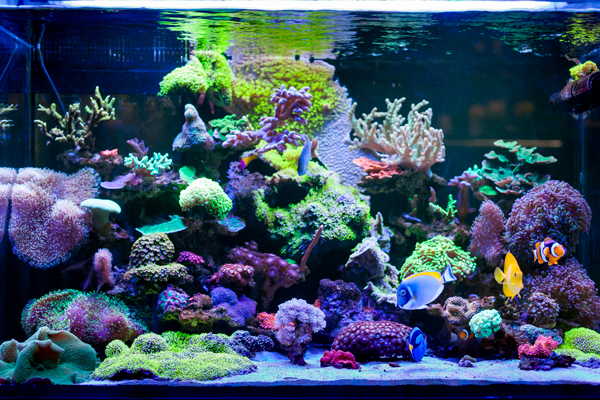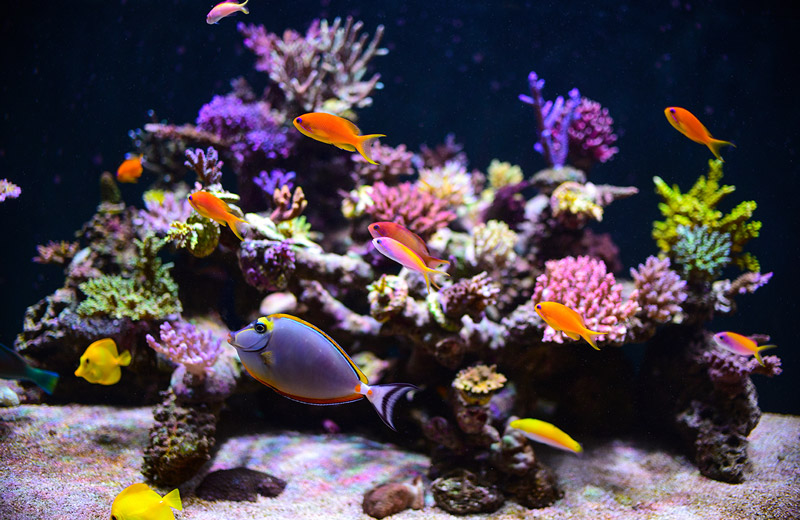Setting up a new saltwater aquarium can appear daunting. However, it’s not too hard with our step by step guide and will be worth it once you have added your fish and are free to enjoy it.
Although a saltwater aquarium can be a little more expensive than a freshwater aquarium it has a smaller margin for error. Saltwater aquariums offer quite a wide range of colorful fish and corals which are not available in freshwater systems.
As you’ll see later in the article, there are generally about eight steps involved in turning a saltwater aquarium into a reality. You’ll notice the process is similar to setting up a freshwater aquarium. However, before we jump into the steps to set up the aquarium, it is important to note there are a few different types of saltwater tanks.
Table of Contents
Types of Saltwater Tanks
There are many things you can do with a saltwater aquarium. We’ll briefly explore some of the types of marine aquarium setups you could have.
Fish Only
Fish are the most popular reason people get a saltwater aquarium. If they are the only thing about a saltwater tank that interests you, then this marine system is for you. It is also the most basic and inexpensive saltwater system one can set up.
For this marine aquarium, you can choose between a species tank or a community tank. A species only tank is one in which only one species should be kept in that tank. This is typically in regard to aggressive or predatory fish that cannot coexist with other species in the same aquarium. Whereas a community tank is just that, a variety of fish species coexisting in the same aquarium.
Although fish only aquariums are the most basic to set up, they may need a little more maintenance than other types simply because without something such as live rock or other items that introduce more beneficial bacteria into the aquarium to help control waste, cycling takes longer and water changes may need to be performed more often in order to keep the water quality high.
Fish Only with Live Rock
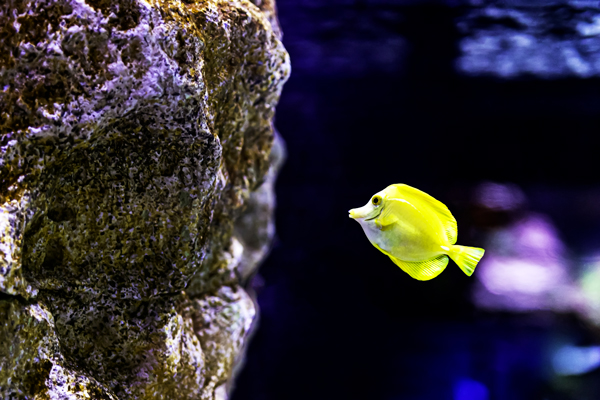
As the name implies, this saltwater tank is fish simply fish with live rock.
As mentioned in the previous section, live rock introduces more beneficial bacteria into the aquarium and helps to keep it clean because the bacteria break down ammonia and nitrites into less toxic nitrate.
Although some people might be skeptical because live rock adds more cost to the aquarium, in the big picture, it really isn’t that much more since live rock is typically only a few dollars per pound with the added bonus of helping maintain water quality and adds visual interest to the aquarium.
Reef Tank
This type of saltwater aquarium is the most striking and what many people first think of when they hear the words “saltwater aquarium”.
The biggest difference with this tank setup is that it has corals, which are living organisms with their own set of needs. It is also the most expensive aquarium type because not only can corals themselves be expensive, they also require extra equipment in order to maintain crucial parameters such as water quality and lighting.
Although this type of aquarium can be a challenge for beginners to maintain, with the right effort and dedication, it can be the most beautiful aquarium you’ll ever have.
Setting Up A Saltwater Aquarium
As mentioned earlier in this article, setting up a saltwater aquarium system is similar to setting up a freshwater aquarium and is simple enough if you know what you’re doing.
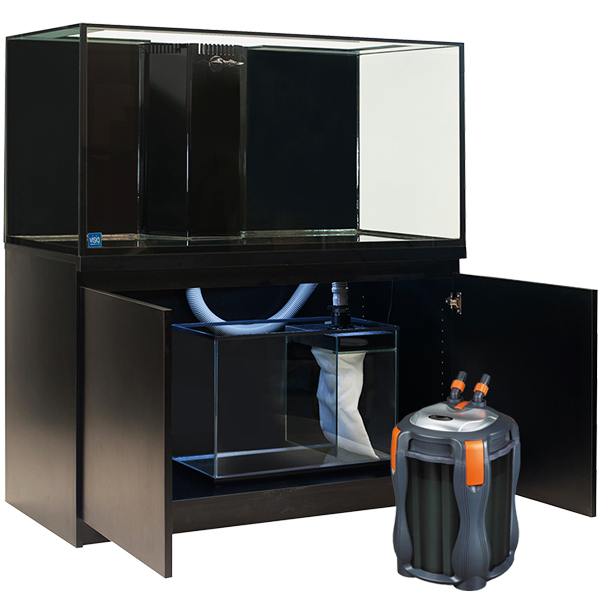
1. Plan Your Tank
Before you purchase anything for your saltwater aquarium, you should plan. Planning will help you thoroughly understand options, pricing, space considerations, and more. It will also make the process much smoother.
The first step in your planning process is deciding what type of tank and fish you want to have because this will affect the rest of the aquarium. Think about their requirements and the rest of your aquarium will begin to take shape.
2. Prepare the Tank
Once you have done research and decided what type of aquarium you want, you can start purchasing everything you’ll need and prepare the tank.
Cleaning Your New Aquarium
Even if your aquarium is new, you’ll still need to clean it. However, never use soap or household cleaners because they leave behind chemicals and residues that will harm or kill the fish and corals.
For new aquariums, simply use a wet cloth to wipe away any dust and particles, or use a natural glass and acrylic cleaner that is safe for aquarium use (we recommend and use Proglow by Tropical Science here at The Ocean Floor). If you have an acrylic tank, it is best to use a lint-free microfiber cloth to clean it because acrylic can scratch easily.
Checking for Leaks
After you’ve cleaned the tank check it for leaks. To do this, add a couple of inches of water and leave it for an hour. If you discover any leaks, they can typically be fixed with aquarium sealant.
Selecting a Safe & Secure Location
Once it is cleaned and checked for leaks, position the aquarium where you want and be sure you are happy with where you are putting it because full aquariums are much heavier and very difficult to move.
Keep in mind that the surface you place the aquarium on needs to strong enough to hold the weight of a full aquarium and any equipment. It must also be level to avoid the danger of falling. Many aquariums have the option of purchasing a matching cabinet stand designed for the type of aquarium you are getting, making it easier to get something you know will work with your aquarium.
3. Add the Substrate
The next step in setting up your tank is adding substrate. There are many different types of substrate, and what type of substrate and how much will need to get will depend on what type of saltwater aquarium you are setting up and what you want it to look like.
Just like the tank, the substrate will also need to be cleaned. A simple rinse before being added to the aquarium will suffice.
In order to avoid inadvertently scratching the tank when adding the substrate place a thin layer along the bottom first, before pouring the rest in.
4. Add the Water
Now that the tank has been cleaned and substrate added, you can start filling it with water. However, you can’t just fill it with water straight from the faucet. The water you put in your saltwater aquarium must have been through reverse osmosis (which you can purchase already in this condition) or use treatments and a de-chlorinater. You also have to add salt mix, which can be found at pet stores that sell fish supplies.
When adding water, it may become cloudy as the substrate is disturbed but don’t worry, it will eventually settle and become clear again.
5. Install Equipment
Although it will depend on what type of saltwater aquarium you are setting up as to what type of equipment you will need to install, nearly all saltwater systems will need a filter at a bare minimum and many need a heater as well. However, it is best to also have additional equipment such as UV sterilizers, lights, protein skimmers, and aerators for maximum benefit to fish health.
Most of the equipment needed for a saltwater aquarium is easy to install, but some filters can be confusing. There are many different types of filters to choose from and each has its own way of being installed, but for installation, it is best to refer to the manual that comes with the equipment or your local fish store for guidance.
When installing the heater, make sure to place the thermometer on the opposite side of the tank from the heater in order to get a more accurate temperature measurement.
6. Add Decorations
At this point you might think it is time to cycle the tank. However, you’ll want to add any decorations you want to the aquarium before cycling because decorations may affect the water.
This is also the phase in which you can really turn that image in your mind into a reality because plants and decorations really allow you to get creative. For example, you can choose to have a natural look with rocks, driftwood, and coral or have a theme such as a shipwreck, pop-culture, or bright, neon-like colors. Just remember to rinse every item before you place it in the aquarium.
7. Cycle the Tank
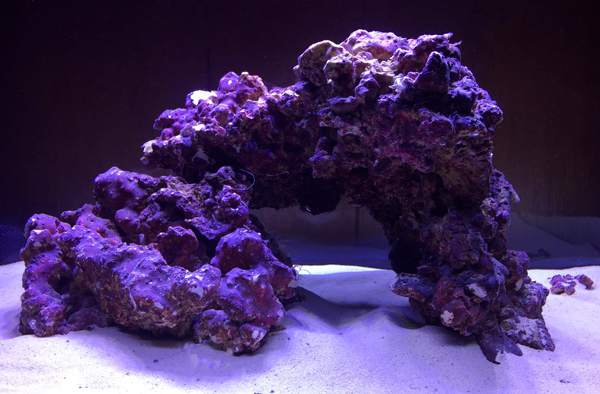
Now that the tank has been fully set up, you must cycle the aquarium in order to make it safe for fish.
The purpose of cycling an aquarium is to build up bacterial cultures to act as a natural biological filter; one culture to convert ammonia to nitrites and the other to convert nitrites to nitrates.
This is necessary because ammonia and nitrite are toxic to fish.
This is also why you regularly perform partial water changes throughout the life of the aquarium: in order to keep levels of them low.
Adding Live Rock or Ammonia
Live rock is commonly used in saltwater aquariums in order to start the cycle because they already hold developed bacteria cultures to add to the tank. A good choice is live rock that is lighter in weight because it is indicative of the rock having a lot of interior gaps and holes which provides more surface area for bacteria to grow.
However, if the Live Rock doesn’t appear to work, you can add some ammonia to kick start the cycle.
Testing the Water
While cycling the aquarium you’ll want to regularly test the water. The ammonia and nitrite levels should spike. The cycle will be complete once these reach 0 ppm. Then conduct a 50% water change to reduce any buildup of nitrates.
The process of cycling should take around 6-8 weeks. If you’d like to speed the process up you can try raising the temperature and oxygen levels or add filter media from an already established aquarium.
8. Add Fish
Finding the right species for your new saltwater aquarium is all about research. You should choose the fish you want before designing and planning the tank because this will affect what you need for your aquarium.
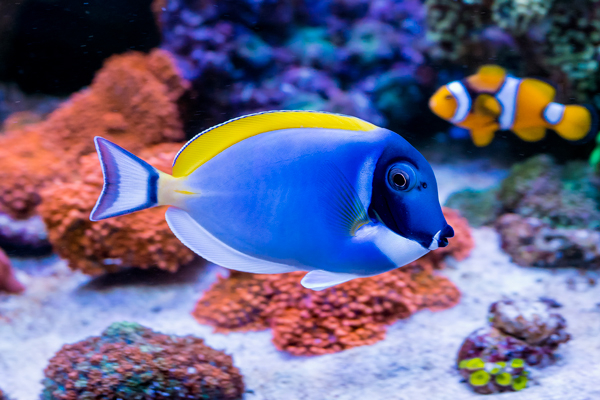
We’re finally at everyone’s favorite part of setting up an aquarium: adding the fish.
Don’t add too many at once, however, or you could run the risk of starting the nitrogen cycle again. It is best to add them slowly over time.
Since fish are sensitive to changes in water conditions, you need to gradually acclimate them to the water in your aquarium before they are added.
How to Acclimate New Fish
The following is one way to acclimate them:
- Float the bag on the water’s surface for 15 minutes in order to match the temperature of the bag to the temperature of the aquarium water.
- Open the bag (making sure it still floats on the surface).
- Add 1/2 a cup of aquarium water to the bag every 4-5 minutes until the bag is full.
- Pour out half the water in bag (not into the aquarium).
- Start adding 1/2 a cup of aquarium water to the bag every 4-5 minutes again until the bag is full.
- Use a fish net to transfer the fish from the bag into the aquarium and discard the bag and water.
You will need to watch your fish over the next 24 hours to ensure they are healthy. Look for any signs of illness or poor health and to see if they are eating at feeding times. The best practice is to use a quarantine tank for fish before adding them to the main aquarium. Doing this helps reduce the risk of inadvertently adding a disease to the aquarium.
Cleaning Your Saltwater Aquarium
You will need to perform water changes regularly in order to keep the health of your aquarium in top condition. Perform water changes about once every two weeks by removing 1/10 of the aquarium water. Make sure when you do it you are also siphoning particulates, uneaten fish food, and other unwanted impurities from the water.
When cleaning the entire aquarium and all the elements inside, the best way is to remove each individual component from your aquarium in sections and placing them in a separate container in order to prevent contamination.
To clean the substrate, begin by taking it and filling a container or bucket 1/3 of the way up with clean, fresh water. When you mix the substrate through the water any dirt or impurities will float to the top. Repeat this step for every item in the aquarium.
Once everything is finished being cleaned, place everything back into your aquarium and refill it with saltwater that was brought to the correct temperature and return the fish to the aquarium.
Feeding Your Saltwater Fish
When deciding what saltwater fish you want for your aquarium it is critical to understand if they are herbivores, carnivores, or omnivores. This will determine their dietary needs and requirements, and you’ll have to provide food accordingly.
Just as setting up an aquarium is meant to replicate their natural living environment in the ocean, their diet should be as natural as possible or at the very least provide the same nutritional value.
Depending on what type of fish you get, some will feed on organisms found in their natural habitat such as krill or plankton. Of course, there are also specialized fish food in flake or pellet form that contain the perfect blend of vitamins and nutrients your saltwater fish need.
Always be cognizant of how much food you provide as well, because a common problem with fish health is overeating. Instructions for feeding can often be found on the package of the fish food, or alternately, seek advice from any fish expert from our store.
See our selection of saltwater fish here.
Summary
A lot of thought and research should go into starting a new aquarium; especially saltwater aquariums because they have a smaller margin for error. The most important aspect is research and planning. If you plan poorly or decide to do things impulsively, you will run into problems later on and can even hurt or kill your fish.
Think about which fish you want to keep and then consider such items as aquarium size, equipment, decorations, substrate, food, filtration, and lighting. It is highly recommended that beginners should pick hardy fish when they start out because they have a greater tolerance to mistakes and errors.
Once everything is planned, the setup process is actually relatively simple. Cycling can take a while, but once you are able to start adding fish you’ll realize it was worth the wait and planning.
If you need help maintaining your saltwater tank learn about our aquarium maintenance and services here.
